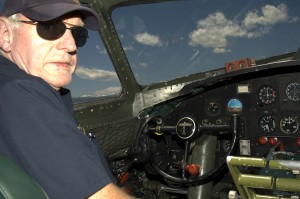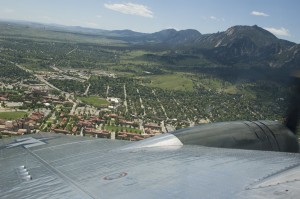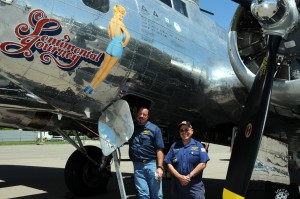By Barry Biggs
While Doris Day may never have met Capt. Robert “Bob” Blue, she and the soft-spoken Commemorative Air Force pilot would be able to strike up a conversation: both have a deep and long-lasting affinity for the moniker “Sentimental Journey.” One prefers it be on the air; the other prefers it be in the air.
Day’s version hit the Billboard charts March 25, 1945, as Columbia Records’ catalog number 36769. Her melodic tones struck the heartstrings of listeners around the world as the war moved reluctantly from Europe to the Pacific.
Blue’s version was accepted into service by the U.S. Army Air Corps just 12 days earlier, on March 13, and was christened 44-85314. With four throaty 1,200-hp radial engines, this Boeing B-17 Flying Fortress filled the hearts of servicemen and women with a sense of pride, and it eventually became an icon of American offensive airpower. Although manufactured far too late to see service in the European theatre, this plane did fly briefly as an RB-17G in the Pacific, fitted as a platform for photo-mapping operations.
More than 60 years later, 85314 is one of only a handful of the B-17s still flying. And while her tail number has changed, and she’s donned a more glamorous designation, Sentimental Journey still reports for duty.
Assigned now to the Arizona Wing of the Commemorative Air Force as a flying museum, Sentimental Journey serves to honor the men who flew and crewed the B-17s during the war, as well as the men and women who built them.
According to the CAF, an educational, historic, preservation, nonprofit organization that restores and flies vintage military aircraft, an average of 80,000 visitors see and pass through the meticulously restored plane during its annual summer tour, which this year brought her to the 2008 Rocky Mountain Metropolitan Airport Open House.
CAF volunteer pilot Blue, who has flown the restored B-17 for seven years, points out Sentimental Journey is as about as authentic as they come.
“This is the most accurately restored B-17 there is,” asserts Blue. “It’s about 96 percent accurately restored.”
Although Sentimental Journey entered service at the tail end of the war, she still had work to do. After her tour in the Pacific, she was transferred to Eglin Field, Fla., and was converted to a DB-17G for service as an air-sea rescue craft.
During the 1950s, she was reconfigured as a DB-17P, serving with the 3215th Drone Squadron at Patrick Air Force Base in Florida. There, in 1951, she took part in “Operation Greenhouse,” the fourth in a series of postwar atmospheric nuclear weapon tests designed to study the principles that would lead to the development of the hydrogen bomb.
During the classified testing, Sentimental Journey was designated as the airborne mother ship, used to remotely fly and control a drone B-17 as it traveled in and out of the target area and collected radioactive cloud samples.
But eight years later, on Jan. 27, 1959, the Air Force mothballed Sentimental Journey and transferred her to storage at Davis Monthan AFB in Tucson, Ariz. But not for long.
According to the War Bird Resource Groups registry for 44-83514, Acme Aircraft Parts of Compton, Calif. briefly picked up Sentimental Journey on July 31, 1959. She was re-designated as a civilian aircraft with a brand new tail number, N-9323Z, which she still wears today.
Western Air Industries, of Anderson, Calif., then acquired Sentimental Journey in November 1962, and converted her from her B-17 configuration to airborne fire tanker #E17. From there, she moved to the Aero Union Corporation of Chico, Calif., where she was flown as #C17 and #17 and eventually restored in 1977 to her military configuration as USAAF483514/Class of ’44.
In January 1978, the storied plane was donated to the newly formed Arizona Wing of the CAF. Local media launched a contest to name the plane. Out of more than 800 entries, “Sentimental Journey” was selected.
But a warbird of this stature needed appropriate nose art. The wing obtained permission from the estate of Betty Grable, who was perhaps the most famous pinup girl of the era, to use her famous pose as part of the finishing touches.
Wing members worked diligently to return Sentimental Journey to her original glory, but even in her pristine condition, she was still missing what really made her a Flying Fortress— four operational turrets, operational bomb bay doors, navigator and radio operator stations, a Norden bomb sight and machine guns.
The next two years found wing members scrounging junkyards and airfields in search of elusive original parts. Seattle-based Boeing Aerospace provided photos and engineering drawings to make the restoration as authentic as possible. Boeing even helped install a new nose turret, the first major piece of equipment of the restoration.
By 1986, Sentimental Journey was an air show favorite, making more than 60 appearances across the U.S. and Canada. In 1988, she suffered a brake failure during a landing at Burbank Airport in California. The accident caused extensive damage to the underside front section of the aircraft and took six months to repair.
CAF wing members made repairs, and Sentimental Journey is once again making the rounds. This year, she and her volunteer crewmembers kicked off their summer tour with a roster that includes stops in 16 states, featuring walk-though tours and rides for some lucky locals who feel that flying aboard Sentimental Journey is well worth the $425 price tag.

Cleared to land, the Flying Fortress is on short final for runway 29R at Rocky Mountain Metro Airport, coming in at about 110 mph.
Passengers, under the watchful eye of the crew chief are free to move about the interior of the aircraft and can sit at most of the plane’s 10 crewmember positions. They can stroll down the catwalk or watch the world pass by from the vantage of the .50-caliber starboard waist gun turret, which has a large acrylic opening for use as an observation platform. It is the perfect roost for any photographer who has the ability to focus with one hand and hang on with the other.
The best seat in the house belonged to the bombardier, who sat tucked in the clear glass bubble beneath the nose. The 180-degree view makes up for a tight fit. Interestingly enough, during wartime operations, the bombardier would actually take control of the plane during bomb runs. Using the B-17’s autopilot controls and famous Norden bombsight, the bombardier would carefully calculate distance, speed and other factors affecting his ability and apply his skills in delivering the payload on target. Then with the “bombs away” command, he returned control of the aircraft to the pilot.
While just the sight of Sentimental Journey is exciting for many, its crewmembers, who rotate throughout the season, will remind guests that she’s not a joy ride: she’s a grand lady and a flying memorial and museum of the men who flew and crewed these airplanes, as well as the men and women who built them more than 60 years ago. Out of 12,731 built, only 10 restored and airworthy examples remain in the country.
“It’s really such a privilege to be part of the B-17,” said Capt. Mike Buckley, Sentimental Journey copilot and CAF director of operations. “It’s a wonderful experience to feel what the guys did before us—to be a part of a plane that’s part of our history—and then be able to go around the country and share that with the public.”
Buckley, who is a retired airline pilot with 35 years under his belt at Northwest, confessed the best part for him was to be able to talk with former B-17 crewmembers.

Capt. Bob Blue, retired after 39 years with United Airlines, has flown the restored B-17 for seven years.
“Whether they were gunners, waist gunners or pilots, it’s always very satisfying to talk to them—and thank them for their service to our country,” he said.
Buckley hopes that during their annual summer tours, future generations will have a better understanding of what the B-17 Flying Fortress did for the nation.
“Hopefully, the younger generations will pick up an appreciation for what we have—and why we have it,” he said.
For more information about Sentimental Journey, including tour stops, visit the Arizona Wing of the CAF at [http://www.azcaf.org], or call 602-448-9415 for information and scheduling of rides. Upcoming stops this summer will include Michigan, Wisconsin, Iowa, Illinois, Missouri, Oklahoma and Texas. A special thanks to Bea Khan Wilhite of the Colorado Aviation Historical Society for making possible the interviews and flight aboard the Sentimental Journey.

















